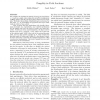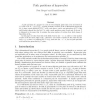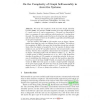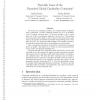53 search results - page 10 / 11 » Bounds on the forcing numbers of bipartite graphs |
SODA
2004
ACM
13 years 9 months ago
2004
ACM
We consider the problem of picking (buying) an inexpensive s-t path in a graph where edges are owned by independent (selfish) agents, and the cost of an edge is known to its owner...
TCS
2010
13 years 2 months ago
2010
Abstract. A trivalent diagram is a connected, two-colored bipartite graph (parallel edges allowed but not loops) such that every black vertex is of degree 1 or 3 and every white ve...
IPL
2008
13 years 7 months ago
2008
A path partition of a graph G is a set of vertex-disjoint paths that cover all vertices of G. Given a set P = {{ai, bi}}m i=1 of pairs of distinct vertices of the n-dimensional hy...
DNA
2006
Springer
13 years 11 months ago
2006
Springer
We study the complexity of the Accretive Graph Assembly Problem (AGAP). An instance of AGAP consists of an edge-weighted graph G, a seed vertex in G, and a temperature . The goal i...
CATS
2008
13 years 9 months ago
2008
We study the consistency problem for extended global cardinality (EGC) constraints. An EGC constraint consists of a set X of variables, a set D of values, a domain D(x) D for eac...




